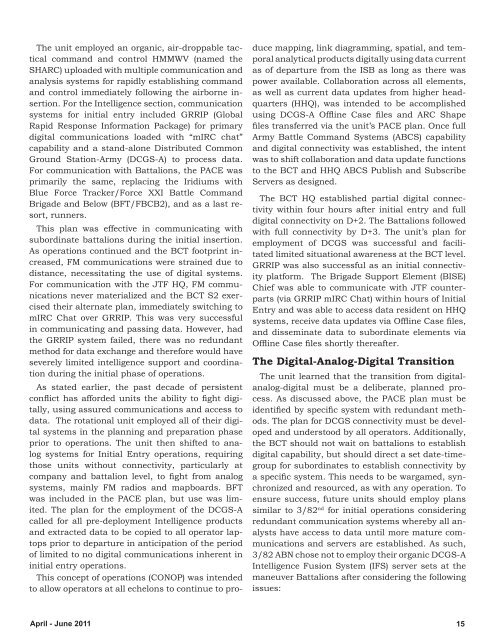George w. casey jr. - Federation of American Scientists
George w. casey jr. - Federation of American Scientists
George w. casey jr. - Federation of American Scientists
You also want an ePaper? Increase the reach of your titles
YUMPU automatically turns print PDFs into web optimized ePapers that Google loves.
The unit employed an organic, air-droppable tactical<br />
command and control HMMWV (named the<br />
SHARC) uploaded with multiple communication and<br />
analysis systems for rapidly establishing command<br />
and control immediately following the airborne insertion.<br />
For the Intelligence section, communication<br />
systems for initial entry included GRRIP (Global<br />
Rapid Response Information Package) for primary<br />
digital communications loaded with “mIRC chat”<br />
capability and a stand-alone Distributed Common<br />
Ground Station-Army (DCGS-A) to process data.<br />
For communication with Battalions, the PACE was<br />
primarily the same, replacing the Iridiums with<br />
Blue Force Tracker/Force XXI Battle Command<br />
Brigade and Below (BFT/FBCB2), and as a last resort,<br />
runners.<br />
This plan was effective in communicating with<br />
subordinate battalions during the initial insertion.<br />
As operations continued and the BCT footprint increased,<br />
FM communications were strained due to<br />
distance, necessitating the use <strong>of</strong> digital systems.<br />
For communication with the JTF HQ, FM communications<br />
never materialized and the BCT S2 exercised<br />
their alternate plan, immediately switching to<br />
mIRC Chat over GRRIP. This was very successful<br />
in communicating and passing data. However, had<br />
the GRRIP system failed, there was no redundant<br />
method for data exchange and therefore would have<br />
severely limited intelligence support and coordination<br />
during the initial phase <strong>of</strong> operations.<br />
As stated earlier, the past decade <strong>of</strong> persistent<br />
conflict has afforded units the ability to fight digitally,<br />
using assured communications and access to<br />
data. The rotational unit employed all <strong>of</strong> their digital<br />
systems in the planning and preparation phase<br />
prior to operations. The unit then shifted to analog<br />
systems for Initial Entry operations, requiring<br />
those units without connectivity, particularly at<br />
company and battalion level, to fight from analog<br />
systems, mainly FM radios and mapboards. BFT<br />
was included in the PACE plan, but use was limited.<br />
The plan for the employment <strong>of</strong> the DCGS-A<br />
called for all pre-deployment Intelligence products<br />
and extracted data to be copied to all operator laptops<br />
prior to departure in anticipation <strong>of</strong> the period<br />
<strong>of</strong> limited to no digital communications inherent in<br />
initial entry operations.<br />
This concept <strong>of</strong> operations (CONOP) was intended<br />
to allow operators at all echelons to continue to produce<br />
mapping, link diagramming, spatial, and temporal<br />
analytical products digitally using data current<br />
as <strong>of</strong> departure from the ISB as long as there was<br />
power available. Collaboration across all elements,<br />
as well as current data updates from higher headquarters<br />
(HHQ), was intended to be accomplished<br />
using DCGS-A Offline Case files and ARC Shape<br />
files transferred via the unit’s PACE plan. Once full<br />
Army Battle Command Systems (ABCS) capability<br />
and digital connectivity was established, the intent<br />
was to shift collaboration and data update functions<br />
to the BCT and HHQ ABCS Publish and Subscribe<br />
Servers as designed.<br />
The BCT HQ established partial digital connectivity<br />
within four hours after initial entry and full<br />
digital connectivity on D+2. The Battalions followed<br />
with full connectivity by D+3. The unit’s plan for<br />
employment <strong>of</strong> DCGS was successful and facilitated<br />
limited situational awareness at the BCT level.<br />
GRRIP was also successful as an initial connectivity<br />
platform. The Brigade Support Element (BISE)<br />
Chief was able to communicate with JTF counterparts<br />
(via GRRIP mIRC Chat) within hours <strong>of</strong> Initial<br />
Entry and was able to access data resident on HHQ<br />
systems, receive data updates via Offline Case files,<br />
and disseminate data to subordinate elements via<br />
Offline Case files shortly thereafter.<br />
The Digital-Analog-Digital Transition<br />
The unit learned that the transition from digitalanalog-digital<br />
must be a deliberate, planned process.<br />
As discussed above, the PACE plan must be<br />
identified by specific system with redundant methods.<br />
The plan for DCGS connectivity must be developed<br />
and understood by all operators. Additionally,<br />
the BCT should not wait on battalions to establish<br />
digital capability, but should direct a set date-timegroup<br />
for subordinates to establish connectivity by<br />
a specific system. This needs to be wargamed, synchronized<br />
and resourced, as with any operation. To<br />
ensure success, future units should employ plans<br />
similar to 3/82 nd for initial operations considering<br />
redundant communication systems whereby all analysts<br />
have access to data until more mature communications<br />
and servers are established. As such,<br />
3/82 ABN chose not to employ their organic DCGS-A<br />
Intelligence Fusion System (IFS) server sets at the<br />
maneuver Battalions after considering the following<br />
issues:<br />
April - June 2011 15















